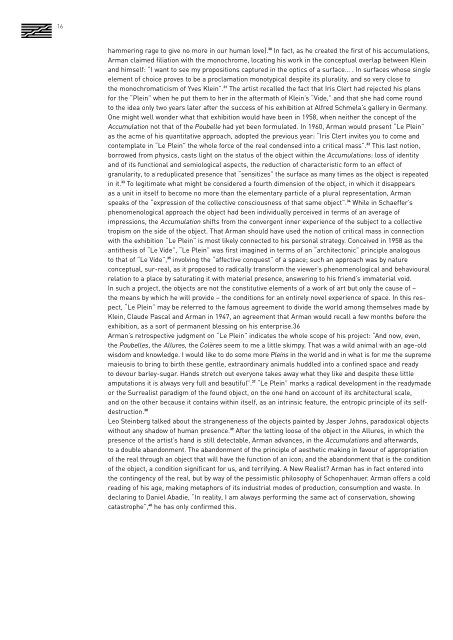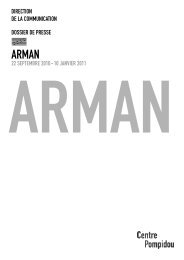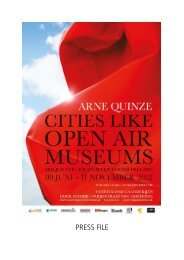Arman - Vicky David Gallery
Arman - Vicky David Gallery
Arman - Vicky David Gallery
You also want an ePaper? Increase the reach of your titles
YUMPU automatically turns print PDFs into web optimized ePapers that Google loves.
16<br />
hammering rage to give no more in our human love). 30 In fact, as he created the first of his accumulations,<br />
<strong>Arman</strong> claimed filiation with the monochrome, locating his work in the conceptual overlap between Klein<br />
and himself: “I want to see my propositions captured in the optics of a surface… . In surfaces whose single<br />
element of choice proves to be a proclamation monotypical despite its plurality, and so very close to<br />
the monochromaticism of Yves Klein”. 31 The artist recalled the fact that Iris Clert had rejected his plans<br />
for the “Plein” when he put them to her in the aftermath of Klein’s “Vide,” and that she had come round<br />
to the idea only two years later after the success of his exhibition at Alfred Schmela’s gallery in Germany.<br />
One might well wonder what that exhibition would have been in 1958, when neither the concept of the<br />
Accumulation not that of the Poubelle had yet been formulated. In 1960, <strong>Arman</strong> would present “Le Plein”<br />
as the acme of his quantitative approach, adopted the previous year: “Iris Clert invites you to come and<br />
contemplate in “Le Plein” the whole force of the real condensed into a critical mass”. 32 This last notion,<br />
borrowed from physics, casts light on the status of the object within the Accumulations: loss of identity<br />
and of its functional and semiological aspects, the reduction of characteristic form to an effect of<br />
granularity, to a reduplicated presence that “sensitizes” the surface as many times as the object is repeated<br />
in it. 33 To legitimate what might be considered a fourth dimension of the object, in which it disappears<br />
as a unit in itself to become no more than the elementary particle of a plural representation, <strong>Arman</strong><br />
speaks of the “expression of the collective consciousness of that same object”. 34 While in Schaeffer’s<br />
phenomenological approach the object had been individually perceived in terms of an average of<br />
impressions, the Accumulation shifts from the convergent inner experience of the subject to a collective<br />
tropism on the side of the object. That <strong>Arman</strong> should have used the notion of critical mass in connection<br />
with the exhibition “Le Plein” is most likely connected to his personal strategy. Conceived in 1958 as the<br />
antithesis of “Le Vide”, “Le Plein” was first imagined in terms of an “architectonic” principle analogous<br />
to that of “Le Vide”, 35 involving the “affective conquest” of a space; such an approach was by nature<br />
conceptual, sur-real, as it proposed to radically transform the viewer’s phenomenological and behavioural<br />
relation to a place by saturating it with material presence, answering to his friend’s immaterial void.<br />
In such a project, the objects are not the constitutive elements of a work of art but only the cause of –<br />
the means by which he will provide – the conditions for an entirely novel experience of space. In this respect,<br />
“Le Plein” may be referred to the famous agreement to divide the world among themselves made by<br />
Klein, Claude Pascal and <strong>Arman</strong> in 1947, an agreement that <strong>Arman</strong> would recall a few months before the<br />
exhibition, as a sort of permanent blessing on his enterprise.36<br />
<strong>Arman</strong>’s retrospective judgment on “Le Plein” indicates the whole scope of his project: “And now, even,<br />
the Poubelles, the Allures, the Colères seem to me a little skimpy. That was a wild animal with an age-old<br />
wisdom and knowledge. I would like to do some more Pleins in the world and in what is for me the supreme<br />
maieusis to bring to birth these gentle, extraordinary animals huddled into a confined space and ready<br />
to devour barley-sugar. Hands stretch out everyone takes away what they like and despite these little<br />
amputations it is always very full and beautiful”. 37 “Le Plein” marks a radical development in the readymade<br />
or the Surrealist paradigm of the found object, on the one hand on account of its architectural scale,<br />
and on the other because it contains within itself, as an intrinsic feature, the entropic principle of its selfdestruction.<br />
38<br />
Leo Steinberg talked about the strangeneness of the objects painted by Jasper Johns, paradoxical objects<br />
without any shadow of human presence. 39 After the letting loose of the object in the Allures, in which the<br />
presence of the artist’s hand is still detectable, <strong>Arman</strong> advances, in the Accumulations and afterwards,<br />
to a double abandonment. The abandonment of the principle of aesthetic making in favour of appropriation<br />
of the real through an object that will have the function of an icon; and the abandonment that is the condition<br />
of the object, a condition significant for us, and terrifying. A New Realist? <strong>Arman</strong> has in fact entered into<br />
the contingency of the real, but by way of the pessimistic philosophy of Schopenhauer. <strong>Arman</strong> offers a cold<br />
reading of his age, making metaphors of its industrial modes of production, consumption and waste. In<br />
declaring to Daniel Abadie, “In reality, I am always performing the same act of conservation, showing<br />
catastrophe”, 40 he has only confirmed this.




